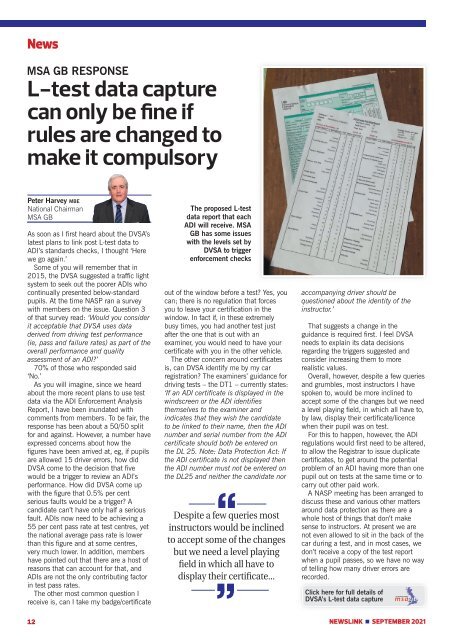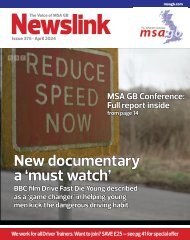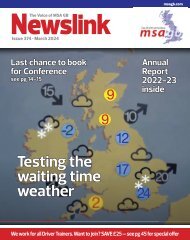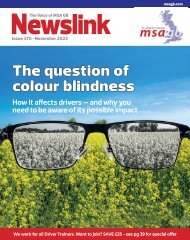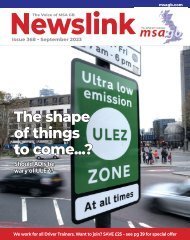Newslink September 2021
Motor Schools Association of Great Britain membership magazine; driving instructors, road safety, motoring news
Motor Schools Association of Great Britain membership magazine; driving instructors, road safety, motoring news
- No tags were found...
Create successful ePaper yourself
Turn your PDF publications into a flip-book with our unique Google optimized e-Paper software.
News<br />
MSA GB RESPONSE<br />
L-test data capture<br />
can only be fine if<br />
rules are changed to<br />
make it compulsory<br />
Peter Harvey MBE<br />
National Chairman<br />
MSA GB<br />
As soon as I first heard about the DVSA’s<br />
latest plans to link post L-test data to<br />
ADI’s standards checks, I thought ‘Here<br />
we go again.’<br />
Some of you will remember that in<br />
2015, the DVSA suggested a traffic light<br />
system to seek out the poorer ADIs who<br />
continually presented below-standard<br />
pupils. At the time NASP ran a survey<br />
with members on the issue. Question 3<br />
of that survey read: ‘Would you consider<br />
it acceptable that DVSA uses data<br />
derived from driving test performance<br />
(ie, pass and failure rates) as part of the<br />
overall performance and quality<br />
assessment of an ADI?’<br />
70% of those who responded said<br />
‘No.’<br />
As you will imagine, since we heard<br />
about the more recent plans to use test<br />
data via the ADI Enforcement Analysis<br />
Report, I have been inundated with<br />
comments from members. To be fair, the<br />
response has been about a 50/50 split<br />
for and against. However, a number have<br />
expressed concerns about how the<br />
figures have been arrived at, eg, if pupils<br />
are allowed 15 driver errors, how did<br />
DVSA come to the decision that five<br />
would be a trigger to review an ADI’s<br />
performance. How did DVSA come up<br />
with the figure that 0.5% per cent<br />
serious faults would be a trigger? A<br />
candidate can’t have only half a serious<br />
fault. ADIs now need to be achieving a<br />
55 per cent pass rate at test centres, yet<br />
the national average pass rate is lower<br />
than this figure and at some centres,<br />
very much lower. In addition, members<br />
have pointed out that there are a host of<br />
reasons that can account for that, and<br />
ADIs are not the only contributing factor<br />
in test pass rates.<br />
The other most common question I<br />
receive is, can I take my badge/certificate<br />
The proposed L-test<br />
data report that each<br />
ADI will receive. MSA<br />
GB has some issues<br />
with the levels set by<br />
DVSA to trigger<br />
enforcement checks<br />
out of the window before a test? Yes, you<br />
can; there is no regulation that forces<br />
you to leave your certification in the<br />
window. In fact if, in these extremely<br />
busy times, you had another test just<br />
after the one that is out with an<br />
examiner, you would need to have your<br />
certificate with you in the other vehicle.<br />
The other concern around certificates<br />
is, can DVSA identify me by my car<br />
registration? The examiners’ guidance for<br />
driving tests – the DT1 – currently states:<br />
‘If an ADI certificate is displayed in the<br />
windscreen or the ADI identifies<br />
themselves to the examiner and<br />
indicates that they wish the candidate<br />
to be linked to their name, then the ADI<br />
number and serial number from the ADI<br />
certificate should both be entered on<br />
the DL 25. Note: Data Protection Act: If<br />
the ADI certificate is not displayed then<br />
the ADI number must not be entered on<br />
the DL25 and neither the candidate nor<br />
‘‘<br />
Despite a few queries most<br />
instructors would be inclined<br />
to accept some of the changes<br />
but we need a level playing<br />
field in which all have to<br />
display their certificate...<br />
‘‘<br />
accompanying driver should be<br />
questioned about the identity of the<br />
instructor.’<br />
That suggests a change in the<br />
guidance is required first. I feel DVSA<br />
needs to explain its data decisions<br />
regarding the triggers suggested and<br />
consider increasing them to more<br />
realistic values.<br />
Overall, however, despite a few queries<br />
and grumbles, most instructors I have<br />
spoken to, would be more inclined to<br />
accept some of the changes but we need<br />
a level playing field, in which all have to,<br />
by law, display their certificate/licence<br />
when their pupil was on test.<br />
For this to happen, however, the ADI<br />
regulations would first need to be altered,<br />
to allow the Registrar to issue duplicate<br />
certificates, to get around the potential<br />
problem of an ADI having more than one<br />
pupil out on tests at the same time or to<br />
carry out other paid work.<br />
A NASP meeting has been arranged to<br />
discuss these and various other matters<br />
around data protection as there are a<br />
whole host of things that don’t make<br />
sense to instructors. At present we are<br />
not even allowed to sit in the back of the<br />
car during a test, and in most cases, we<br />
don’t receive a copy of the test report<br />
when a pupil passes, so we have no way<br />
of telling how many driver errors are<br />
recorded.<br />
Click here for full details of<br />
DVSA’s L-test data capture<br />
12<br />
NEWSLINK n SEPTEMBER <strong>2021</strong>


